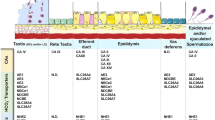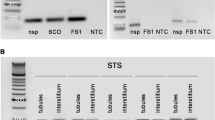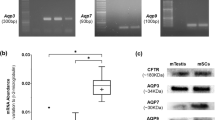Abstract
The formation of competent spermatozoa is a complex event that depends on the establishment of adequate environments throughout the male reproductive tract. Bicarbonate is essential not only to ionic homeostasis but also to pH maintenance along the male reproductive tract. Previous studies support an association of high 17β-estradiol (E2) levels with modulation of specific ion transporters expression. Herein we determined the effect of E2 on the expression/functionality of SLC4 family bicarbonate transporters in rat Sertoli cells (SCs). All studied transporters [anion exchanger 2 (AE2), Na+-driven Cl−/HCO3 − exchanger (NDCBE), electrogenic Na+/HCO3 − co-transporters (NBCe1), and electroneutral Na+/HCO3 − co-transporters (NBCn1)] were identified in SCs, being AE2 and NBCn1 the most abundant. In E2-treated cells (100 nM), increases in AE2 and NBCn1 protein levels were observed, as well as altered transcellular transport. E2-treated SCs presented a significant perturbation of ATP-induced short-circuit current. This alteration was concurrent with augmented AE2 and NBCn1 levels. Overall, we report a relation between increased E2 levels and the expression/function of AE2 and NBCn1 in rat SCs, providing new evidence on the mechanisms by which E2 can regulate SCs physiology and consequently spermatogenesis, with direct influence on male reproductive potential.





Similar content being viewed by others
References
Oliveira PF, Sousa M, Barros A, Moura T, da Costa AR (2009) Membrane transporters and cytoplasmatic pH regulation on bovine Sertoli cells. J Membr Biol 227:49–55. doi:10.1007/s00232-008-9139-z
Oliveira PF, Sousa M, Barros A, Moura T, da Costa AR (2009) Intracellular pH regulation in human Sertoli cells: role of membrane transporters. Reproduction 137:353–359. doi:10.1530/REP-08-0363
Bernardino RL, Jesus TT, Martins AD, Sousa M, Barros A, Cavaco JE, Socorro S, Alves MG, Oliveira PF (2013) Molecular basis of bicarbonate membrane transport in the male reproductive tract. Curr Med Chem 20:4037–4049. doi:10.2174/15672050113109990200
Casey JR, Grinstein S, Orlowski J (2009) Sensors and regulators of intracellular pH. Nat Rev Mol Cell Biol 11:50–61. doi:10.1038/nrm2820
Liu Y, Wang D-K, Chen L-M (2012) The physiology of bicarbonate transporters in mammalian reproduction. Biol Reprod 86:99. doi:10.1095/biolreprod.111.096826
Hess RA, Gist DH, Bunick D, Lubahn DB, Farrell A, Bahr J, Cooke PS, Greene GL (1997) Estrogen receptor (α and β) expression in the excurrent ducts of the adult male rat reproductive tract. J Androl 18:602–611. doi:10.1002/j.1939-4640.1997.tb02437.x
Oliveira PF, Alves MG, Martins AD, Correia S, Bernardino RL, Silva J, Barros A, Sousa M, Cavaco JE, Socorro S (2014) Expression pattern of G protein-coupled receptor 30 in human seminiferous tubular cells. Gen Comp Endocrinol 201:16–20. doi:10.1016/j.ygcen.2014.02.022
Heldring N, Pike A, Andersson S, Matthews J, Cheng G, Hartman J, Tujague M, Ström A, Treuter E, Warner M (2007) Estrogen receptors: how do they signal and what are their targets. Physiol Rev 87:905–931. doi:10.1152/physrev.00026.2006
Hammes SR, Levin ER (2007) Extranuclear steroid receptors: nature and actions. Endocr Rev 28:726–741. doi:10.1210/er.2007-0022
Cavaco JEB, Laurentino SS, Barros A, Sousa M, Socorro S (2009) Estrogen receptors α and β in human testis: both isoforms are expressed. Syst Biol Reprod Med 55:137–144. doi:10.3109/19396360902855733
Rago V, Romeo F, Giordano F, Maggiolini M, Carpino A (2011) Identification of the estrogen receptor GPER in neoplastic and non-neoplastic human testes. Reprod Biol Endocrinol 9:1186. doi:10.1186/1477-7827-9-135
Clulow J, Jones R (2004) Composition of luminal fluid secreted by the seminiferous tubules and after reabsorption by the extratesticular ducts of the Japanese quail, Coturnix coturnix japonica. Biol Reprod 71:1508–1516. doi:10.1095/biolreprod.104.031401
Rato L, Socorro S, Cavaco JEB, Oliveira PF (2010) Tubular fluid secretion in the seminiferous epithelium: ion transporters and aquaporins in Sertoli cells. J Membr Biol 236:215–224. doi:10.1007/s00232-010-9294-x
Zhou Q, Clarke L, Nie R, Carnes K, Lai L-W, Lien Y-HH, Verkman A, Lubahn D, Fisher JS, Katzenellenbogen BS (2001) Estrogen action and male fertility: roles of the sodium/hydrogen exchanger-3 and fluid reabsorption in reproductive tract function. Proc Natl Acad Sci USA 98:14132–14137. doi:10.1073/pnas.241245898
Oliveira PF, Alves MG, Rato L, Laurentino S, Silva J, Sa R, Barros A, Sousa M, Carvalho RA, Cavaco JE, Socorro S (2012) Effect of insulin deprivation on metabolism and metabolism-associated gene transcript levels of in vitro cultured human Sertoli cells. Biochim Biophys Acta 1820:84–89. doi:10.1016/j.bbagen.2011.11.006
Hess RA (2000) Oestrogen in fluid transport in efferent ducts of the male reproductive tract. Rev Reprod 5:84–92. doi:10.1530/ror.0.0050084
Bernardino RL, Martins AD, Socorro S, Alves MG, Oliveira PF (2013) Effect of prediabetes on membrane bicarbonate transporters in testis and epididymis. J Membr Biol 246:877–883. doi:10.1007/s00232-013-9601-4
Rato L, Duarte AI, Tomás GD, Santos MS, Moreira PI, Socorro S, Cavaco JE, Alves MG, Oliveira PF (2013) Pre-diabetes alters testicular PGC1-α/SIRT3 axis modulating mitochondrial bioenergetics and oxidative stress. Biochim Biophys Acta 1837:335–344. doi:10.1016/j.bbabio.2013.12.008
Pfaffl MW (2001) A new mathematical model for relative quantification in real-time RT–PCR. Nucleic Acids Res 29:e45. doi:10.1093/nar/29.9.e45
Skalli M, Avallet O, Vigier M, Saez J (1992) Opposite vectorial secretion of insulin-like growth factor I and its binding proteins by pig Sertoli cells cultured in the bicameral chamber system. Endocrinology 131:985–987. doi:10.1210/endo.131.2.1379171
Ko W, Chan HC, Chew S, Wong P (1998) Regulated anion secretion in cultured epithelia from Sertoli cells of immature rats. J Physiol 512:471–480. doi:10.1111/j.1469-7793.1998.471be.x
Oliveira PF, Lopes IA, Barrias C, Rebelo da Costa AM (2004) H+-ATPase of crude homogenate of the outer mantle epithelium of Anodonta cygnea. Comp Biochem Physiol A: Mol Integr Physiol 139:425–432. doi:10.1016/j.cbpb.2004.07.004
Holappa K, Mustonen M, Parvinen M, Vihko P, Rajaniemi H, Kellokumpu S (1999) Primary structure of a sperm cell anion exchanger and its messenger ribonucleic acid expression during spermatogenesis. Biol Reprod 61:981–986. doi:10.1095/biolreprod61.4.981
O’shaughnessy P, Abel M, Charlton H, Hu B, Johnston H, Baker P (2007) Altered expression of genes involved in regulation of vitamin A metabolism, solute transportation, and cytoskeletal function in the androgen-insensitive tfm mouse testis. Endocrinology 148:2914–2924. doi:10.1210/en.2006-1412
Grichtchenko II, Choi I, Zhong X, Bray-Ward P, Russell JM, Boron WF (2001) Cloning, characterization, and chromosomal mapping of a human electroneutral Na+-driven Cl-HCO3 exchanger. J Biol Chem 276:8358–8363. doi:10.1074/jbc.C000716200
Damkier HH, Nielsen S, Praetorius J (2007) Molecular expression of SLC4-derived Na+-dependent anion transporters in selected human tissues. Am J Physiol Regul Integr Comp Physiol 293:R2136–R2146. doi:10.1152/ajpregu.00356.2007
Majumdar D, Maunsbach AB, Shacka JJ, Williams JB, Berger UV, Schultz KP, Harkins LE, Boron WF, Roth KA, Bevensee MO (2008) Localization of electrogenic Na/bicarbonate cotransporter NBCe1 variants in rat brain. Neuroscience 155:818–832. doi:10.1016/j.neuroscience.2008.05.037
Hollams EM, Giles KM, Thomson AM, Leedman PJ (2002) mRNA stability and the control of gene expression: implications for human disease. Neurochem Res 27:957–980. doi:10.1023/A:1020992418511
Ko WH, Wong YD, Leung PY, Chan HC (1996) Apical ATP stimulates electrogenic anion secretion in cultured Sertoli cells from immature rats. J Physiol 419:16. doi:10.1111/j.1469-7793.1998.471be.x
Choi I, Aalkjaer C, Boulpaep EL, Boron WF (2000) An electroneutral sodium/bicarbonate cotransporter NBCn1 and associated sodium channel. Nature 405:571–575. doi:10.1038/35014615
Park M, Ko SBH, Choi JY, Muallem G, Thomas PJ, Pushkin A, Lee M-S, Kim JY, Lee MG, Muallem S, Kurtz I (2002) The cystic fibrosis transmembrane conductance regulator interacts with and regulates the activity of the HCO salvage transporter human Na+-HCO cotransport isoform 3. J Biol Chem 277:50503–50509. doi:10.1074/jbc.M201862200
Romero MF, Chen A-P, Parker MD, Boron WF (2013) The SLC4 family of bicarbonate transporters. Mol Aspects Med 34:159–182. doi:10.1016/j.mam.2012.10.008
Auzanneau C, Thoreau V, Kitzis A, Becq F (2003) A novel voltage-dependent chloride current activated by extracellular acidic pH in cultured rat Sertoli cells. J Biol Chem 278:19230–19236. doi:10.1074/jbc.M301096200
Auzanneau C, Norez C, Noël S, Jougla C, Becq F, Vandebrouck C (2006) Pharmacological profile of inhibition of the chloride channels activated by extracellular acid in cultured rat Sertoli cells. Reprod Nutr Dev 46:241–255. doi:10.1051/rnd:2006013
Acknowledgments
This work was supported by the “Fundação para a Ciência e a Tecnologia”—FCT (PTDC/QUIBIQ/121446/2010 and PEst-OE/SAU/UI0709/2014) co-funded by Fundo Europeu de Desenvolvimento Regional—FEDER via Programa Operacional Factores de Competitividade—COMPETE/QREN. UMIB is funded by FCT-Foundation for Science and Technology, under the project Pest-OE/SAU/UI0215/2014. M.G. Alves (SFRH/BPD/80451/2011) was funded by FCT. P.F. Oliveira was funded by FCT through FSE and POPH funds (Programa Ciência 2008).
Conflict of interest
Authors have no conflict of interest.
Author information
Authors and Affiliations
Corresponding author
Rights and permissions
About this article
Cite this article
Bernardino, R.L., Martins, A.D., Jesus, T.T. et al. Estrogenic regulation of bicarbonate transporters from SLC4 family in rat Sertoli cells. Mol Cell Biochem 408, 47–54 (2015). https://doi.org/10.1007/s11010-015-2481-4
Received:
Accepted:
Published:
Issue Date:
DOI: https://doi.org/10.1007/s11010-015-2481-4




